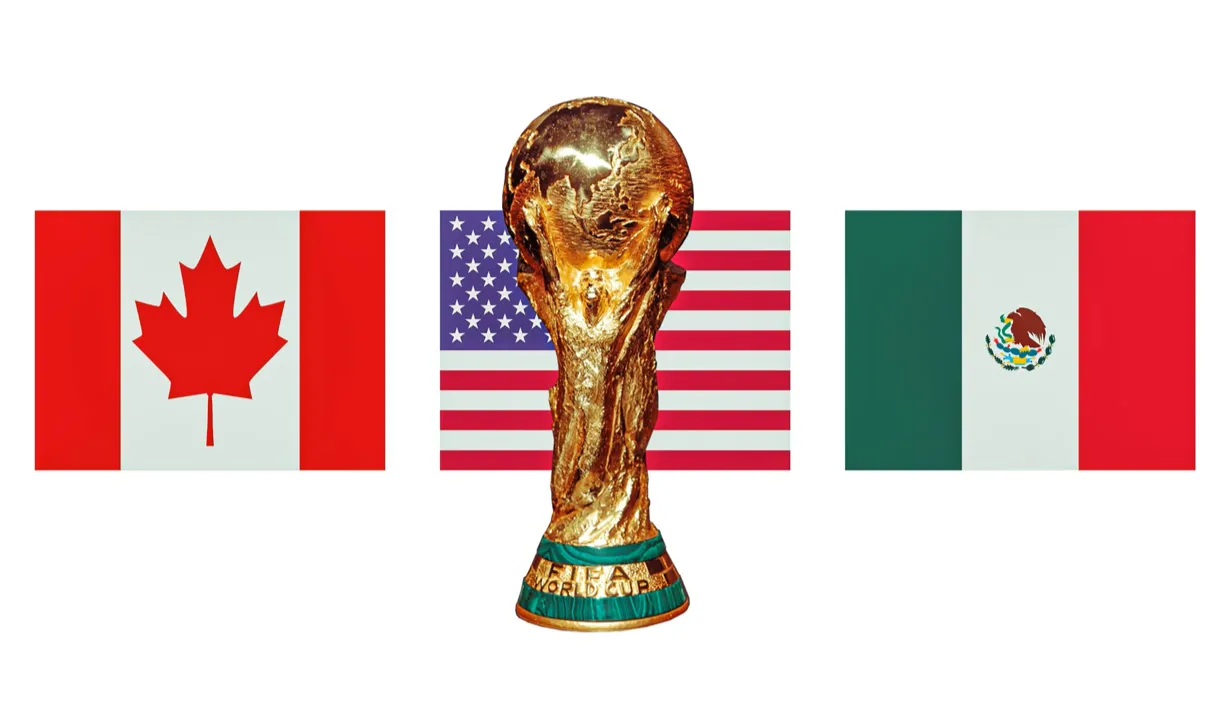
World Cup 2026 Playbook: What Smart Hotel Owners Are Doing Right Now (Before December 5th) ⚽And tips from Taylor Swift hotel storm
By:- David Zaltzman
If you operate a hotel in Atlanta, Dallas, Houston, Kansas City, LA, Miami, New York, Philadelphia, San Francisco, Seattle, Boston, Vancouver, Toronto, Guadalajara, Mexico City, or Monterrey, the next six months will define whether you capitalize on the biggest sporting event North America has ever hosted, or watch competitors pocket the profits.
The 2026 FIFA World Cup represents a once-in-a-generation revenue opportunity, but the window to position strategically is closing fast.
Here’s what the data shows, and more importantly, what you should be doing right now to win.
THE REALITY CHECK: It’s an ADR Game, Not an Occupancy Play Vancouver hotels are already quoting 200% premiums. Toronto’s averaging $600/night.
Gateway markets are preparing for stratospheric rates.
But here’s what most operators are missing: RevPAR growth will come almost entirely from rate increases, not filling more rooms.
Corporate clients are already booking around you. Meeting planners are avoiding their meetings at that crazy time. You’ll see three-day rate explosions around games, then soft shoulders where your base business has been displaced.
The math works but only if your strategy accounts for this displacement reality.
YOUR CRITICAL TIMELINE: DECEMBER 5TH CHANGES EVERYTHING
The World Cup draw on December 5th is your actual starting gun for bookings. Right now, forward reservations remain light because fans are waiting to see where their teams play.
Once brackets drop, expect a booking tsunami within 48-72 hours.
Hotels treating this like a normal booking curve will get caught flat-footed when international and domestic fans flood channels simultaneously.
YOUR PRE-DECEMBER 5TH ACTION PLAN
1. BUILD YOUR RATE STRATEGY NOW. Don’t Wait for Demand.
What to do:
Create match-day rate floors immediately. Determine your absolute minimum rate for each match window (many markets should be thinking 3-5x normal rates).
Develop tiered pricing by match importance. Group stage matches ≠ knockout rounds ≠ semifinals.
Your rate structure should reflect this.
– Set intelligent minimum night requirements. 3-4 night minimums around matches protect you from one-night cherry-pickers while maximizing total revenue.
– Implement dynamic pricing automation. Manual rate management won’t keep pace with real-time demand shifts once the draw happens.
Pro move: Run scenario modeling for different match configurations. If your city gets a quarterfinal vs. just group stage games, your strategy should flex accordingly.
2. Make Displacement Decisions Strategically
What to do:
Audit your current bookings through June-July 2026. Identify which corporate contracts and group blocks occupy your prime match windows.
Renegotiate or release strategically. Calculate the opportunity cost: is that $150 corporate rate worth blocking $600 World Cup demand?
Communicate displacement plans to key accounts NOW. Give your best corporate clients 6+ months notice and first right of refusal at adjusted rates. Preserve relationships while capturing upside.
Create “protected” inventory for strategic accounts. Reserve 10-15% of rooms for key corporate clients at premium (but not stratospheric) rates to maintain long-term partnerships.
Reality check: The corporate business you displace in June 2026 is the business you’ll want back in August 2026. Handle this gracefully.
3. Fix Your Distribution Before the Flood
What to do:
Close OTA channels for match windows NOW. You don’t need to pay 15-20% commission when demand will be white-hot. Drive direct bookings.
Build a World Cup direct booking campaign. Create dedicated landing pages, email campaigns to past guests, and leverage social media to capture direct reservations. Restrict inventory by channel. If you keep OTAs open, give them limited allocation at your highest rates. Reserve your best inventory for direct and high-value channels.
Set up group RFP protocols. Tour operators, travel agencies, and corporate groups are already planning. Create standardized World Cup packages and minimum rates to avoid negotiating every deal individually.
Warning: If you’re not controlling distribution now, OTAs will lock in inventory at pre-surge rates through contracted allotments. Close those loopholes.
4. Operational Readiness = Revenue Protection
What to do:
Stress-test your operations. Can your front desk handle check-ins for 200+ international guests arriving simultaneously? Can F&B handle triple normal breakfast volumes?
Hire and train NOW for June 2026. Don’t wait until April. The labor market in your city will be chaotic as every hotel, restaurant, and venue competes for staff.
Upgrade technology infrastructure. Your PMS, payment processing, and WiFi infrastructure will be tested like never before. International guests with high expectations won’t tolerate failures.
Build multilingual capabilities. Signage, staff training, and guest communications should accommodate Spanish, Portuguese, German, French, and other major languages.
Stock FF&E strategically. Bathroom amenities, linens, and consumables will face supply chain pressure across your market. Order early.
Hard truth: A single service failure during a high-profile international event creates reputation damage that social media amplifies globally. Operational excellence isn’t optional, it’s revenue protection.
5. Prepare for the Visa/International Travel Wildcards
What to do:
Don’t over-index on international demand. U.S. visa processing delays and geopolitical uncertainties may suppress some international arrivals, particularly from non-waiver countries.
Build domestic demand strategies. American soccer fans will travel in huge numbers. Market aggressively to domestic markets, especially for group stage matches.
Create flexible cancellation policies for international bookings. Visa denials are real. Building some flexibility protects your reputation while still capturing premium rates.
Partner with visa service providers. Offer concierge-level visa application support for international guests willing to book early at premium rates.
6. Win the Reputation Game. It Extends Beyond July
What to do:
Set guest experience protocols NOW. Train staff on what “World Cup service excellence” means. High rates = high expectations.
Monitor online reputation obsessively. During the tournament, respond to reviews within hours, not days. One viral complaint can cost you more than match-week revenue gains.
Create “wow” moments. Small touches such as welcome amenities in national team colors, local soccer viewing parties, partnerships with local experiences, create social media buzz and repeat guests.
Document everything. Photos, videos, testimonials from the World Cup period become powerful marketing assets for years.
Long game: The infrastructure investments, operational improvements, and reputation gains from hosting World Cup guests create legacy value. This isn’t just about June-July 2026 revenue, it’s about positioning for years of elevated performance.
MARKET-SPECIFIC CONSIDERATIONS
Gateway Cities (New York, Miami, LA, San Francisco):
You have infrastructure advantages and global draw. Your challenge is avoiding complacency. Demand will be strong, your opportunity is in maximizing rate capture and creating VIP experiences that command 5-10x premiums.
Emerging Markets (Dallas, Atlanta, Kansas City):
This could be your best summer on record. Your opportunity is in market education—many international travelers don’t know your cities. Partner with CVBs, create destination packages, and lean into your underdog status.
Canadian Markets (Vancouver, Toronto):
You’re already seeing early booking pressure and rate spikes. Focus on displacement strategy and international guest experience. Your visa/entry advantages for global travelers are competitive edges.
Border Markets (Guadalajara, Monterrey, Mexico City):
Cross-border travel patterns will be unique. Shuttle services, package deals with U.S. host cities, and bilingual excellence will differentiate winners from those who simply raise rates.
THE MISTAKES TO AVOID
- Waiting until Spring 2026 to finalize strategy (too late, demand patterns lock in post-draw)
- Setting rates without displacement analysis (you’ll block high-value demand with low-value bookings)
- Ignoring operational readiness (service failures destroy premium positioning)
- Over-relying on international demand (visa/geopolitical wildcards are real)
- Treating this like a normal peak season
THE BOTTOM LINE
The 2026 World Cup represents a once-in-a-generation opportunity to capture rates you may never see again, but only if you position strategically in the next 6 months. December 5th is your starting gun. The hotels that win will be those who’ve already built rate
strategies, made displacement decisions, fixed distribution, and prepared operations.
The hotels that lose will be those who wait for demand to appear, then scramble reactively while competitors capture the upside.
The game starts now. What’s your first move (….besides setting up your picture-perfect, Instagram-worthy corner)?
Are you operating in a host market? What’s your biggest strategic question about World Cup planning? Drop a comment. Let’s solve this together.
#WorldCup2026 #HotelStrategy #RevenueManagement #HospitalityLeadership #FIFA2026 #HotelOwners #ADRStrategy #HotelOperations #TravelTrends




